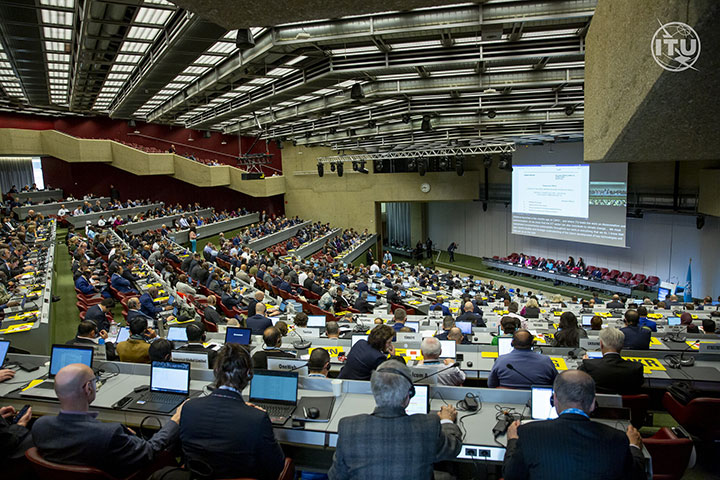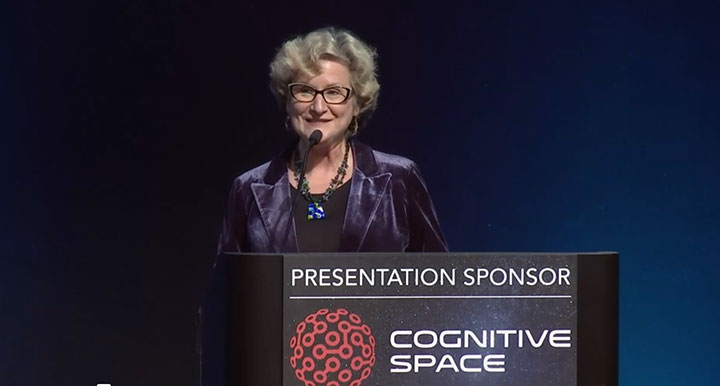 Representatives of ITU member states gather at the World Radiocommunications Conference every four years. The 2023 WRC will be held in November in Dubai. (Source: ITU)
Representatives of ITU member states gather at the World Radiocommunications Conference every four years. The 2023 WRC will be held in November in Dubai. (Source: ITU)
MOUNTAIN VIEW, Calif. — Compared to the thrill of the launchpad or the first cell phone call from space, satellite regulations are far from the most exciting part of the industry. But as regulators and experts emphasized, these rules of the road are critical to any company that is part of the space network.
Over the past six months, the U.S. Federal Communications Commission put a spotlight on the importance of satellite regulations in standing up the Space Bureau. Amid a flood of more than 56,000 satellite applications—twice as many as the FCC was dealing with four years ago—the bureau has begun work to improve satellite licensing as well as clarifying processes for legacy and new space technologies.
FCC Chairwoman Jessica Rosenworcel described the decision to stand up a separate office for space during an address at the Satellite Innovation conference in Mountainview, Calif., last week. “There are now so many new technologies in the space industry, so many applications pending before the agency and so many more innovations on the horizon, that I said the agency can’t keep doing things the old way and expect to thrive in the new.”
Julie Kearney, head of the FCC’s Space Bureau, identified specific steps undertaken since the bureau opened its doors in April.
- Additional spectrum was allocated in the 2 GHz band to support critical communications during space launch, along with new rules prioritizing launch communications.
- A slate of rules aimed at expediting the processing of applications for satellites and ground stations was adopted in September. Specifically, these rules:
- establish timeframes for placing satellite and Earth station applications on notice for public comment;
- allow applications to operate in frequencies where there is not already an international allocation for the satellite services;
- allow non-geostationary orbit (NGSO) licensees to have more than one unbuilt system without facing penalties, such as the potential dismissal of their applications;
- streamline the processing of Earth station operators’ requests to add space stations as points of communication.
- In early October, the commission issued its first enforcement action fining DISH $150,000 for failing to deorbit the EchoStar-7. The fine was related to the FCC’s 2022 rule, updating requirements for LEO operators to deorbit satellites within five years of the end of their mission, as part of an effort to mitigate orbit debris.
- The bureau is currently reviewing responses from industry regarding possible regulations of in-space servicing and manufacturing (ISAM).
- The FCC has launched a series of transparency initiatives, including how-to videos, filing system improvements and workshops to help space applicants navigate the licensing process.
Can Regulation and Innovation Coexist?
While the formation of the regulatory office was intended to create the technical capacity to support industry and enhance competition, reactions to it have been mixed.
According to Kearney, the Space Bureau views its role as promoting innovation and investment across the space economy. Noting more than $280 billion in private equity has been invested in the space sector over the last decade, Kearney argued, “Regulatory transparency and predictability will only propel this investment trajectory.”
 Chief of the FCC’s Space Bureau, Julie Kearney, addresses an audience at Satellite Innovation, Oct. 17, 2023, in Mountainview, Calif. (Source: Silicon Valley Space Week / Satnews Publishers)
Chief of the FCC’s Space Bureau, Julie Kearney, addresses an audience at Satellite Innovation, Oct. 17, 2023, in Mountainview, Calif. (Source: Silicon Valley Space Week / Satnews Publishers)
Among individuals who spoke to Constellations on background, there was optimism that new rules could streamline paperwork and help companies reach business goals more efficiently. There was also skepticism. Several industry players voiced concerns about bureaucracy becoming a barrier to innovation. There were also questions about how the office will help position U.S. business interests globally and how it might affect the emerging competition for scarce spectrum resources.
Space Priorities at WRC 2023
During an address on the global regulatory agenda for RF spectrum resources, Katherine Gizinski, CEO of the tech advisory group River Advisors (formerly ManSat), urged members of the satellite industry to secure a seat at the table as the rules are written for national and international spectrum use.
“We’re moving fast as an industry. Now, we’ve gotten to a point where we’re so fast, we outpaced the regulation,” Gizinski said. “So, technologists in the room, great job. You beat the game. But we have an obligation to bring the regulation along with us.”
The upcoming World Radiocommunication Conference (WRC) in Dubai, from Nov. 20 – Dec. 15, will be pivotal for space players, as the decisions made there will impact everyone in the space ecosystem.
“Whether you are a satellite operator or your clients or your partners are satellite operators, you ought to be tracking this,” Gizinski emphasized. “Because it influences everything from where your R&D dollars should be going to how likely your sales pipeline is to materialize, or for startups…how far away you really are from generating revenue.”
The top agenda items at WRC 2023 that will impact the satellite sector regionally or globally include the following.
- An effort is being made by mobile network operators to grab additional C-band spectrum, which could encroach on existing satellite allocations (Agenda Item 1.2).
- Mobile services in C-band could be upgraded from secondary to primary, which would mean less protection for satellite services (Agenda Item 1.3).
- There could be an expansion of uses for existing satellite bands, including Ku-band uplink for aero and maritime connectivity with NGSO or GSOs and approval of Ka-band for inter-satellite links (Agenda Items 1.15 – 1.17).
- An additional 400 MHz of Ka-band spectrum could be opened up for satellite use. (Agenda Item 1.19).
- The final agenda item will set the stage for studies to be completed for WRC 2027 (Agenda Item 10). These study items include the technical and operational characteristics for direct-to-device (sat-to-cell) communications, allocation of spectrum for 6G, technical and operational characteristics for mobility applications in Q/V bands and regulatory provisions for spectrum sharing between NGSO and GSO frequency bands.
The FCC will be among the leading U.S. voices advocating for government and industry interests at WRC this year. According to Kearney, this will include prioritizing space communications.
“At WRC, the U.S. is leading on import issues like…supporting identification of additional spectrum for Earth stations in motion, or EIMS, space-to-space links, fixed satellite or FSS service and mobile satellite service, as well as important aspects of GSO and NGSO sharing and even looking at the future of communications on the moon,” she said.
The fact that WRC takes place every four years has been a driver for more satellite industry players to be engaged in the process. Regulatory timelines continue to be long, with up to four years to get a new technology study item on WRC’s agenda and another four years before the international body can consider action on it.
Explore More:
How Satellite Can Tap a $74B Opportunity to Connect the Unconnected
Industry Split Over Designating Space Sector as Critical Infrastructure
Crowded Spectrum Pushing Satcom Operators into Q/V Band
Podcast: Space-as-a-Service, 3D Printed Satellites and the Process of Spectrum Licensing
